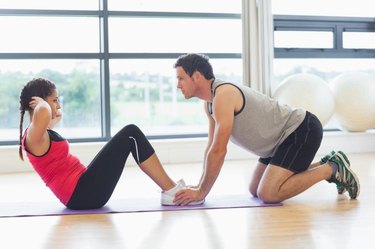
Chances are you first learned how to do sit-ups in gym class — after all, this exercise has been around forever. However, sit-ups are deceptively challenging, so if you can do rep after rep of sit-ups without feeling a burn in your abs, there are two things that you might need to change: Make the exercise more challenging or adjust your form.
To make the exercise more challenging, you can simply perform more reps, add more sets or hold a dumbbell to your chest. If you still don't feel sit-ups in your abs or if you feel sit-ups mostly in other muscles, you should try adjusting your form. Look out for some common issues that can arise when doing sit-ups.
Video of the Day
Video of the Day
Problem: Tight Back Muscles
When you use your abs in a movement such as the sit-up, your back should round forward. Your abs start at the bottom of your ribs and attach to the front of your hips, and when they flex, they move your ribs and hips toward each other. Your lower back muscles do the opposite movement, arching your back instead of rounding it.
If your lower back muscles are too tight and strong, they could prevent your abs from fully rounding your back. If your lower back is arched, it means your abs aren't fully doing their job — and they aren't working as hard as they should.
How to Fix It
If you want to overpower your lower back muscles, get into a sit-up position with your back and head flat on the ground. Before you do a sit-up, actively try to press your lower back down into the ground. This simple movement forces your abs to overpower the lower back muscles that cause your lower back to arch. Then you can go into your sit-up as you normally would.
Tip
If you're having trouble visualizing this, try putting a rolled up towel or even your hands under your lower back. Press your lower back down into the object as hard as you can, then go right into your sit-up.
Problem: Too Much Hip Flexor
In the sit-up position, your hip flexors are actually in a position to pull you up. That's because they run all the way from the top of your leg to your spine. If you want to work your abs, your hip flexors can take over if you're not careful. You might even feel sit-ups in your hip flexors more than your abs.
How to Fix It
If you normally do sit-ups with something holding your feet down, it encourages you to use your hip flexors. Instead, try this sit-up variation: the single-leg sit-up. Lie on the ground on your back with one leg straight and the other leg bent.
The foot of your bent leg should be flat on the floor with your heel close to your butt. Then, perform a sit-up, rolling yourself up to the bent leg. Do as many repetitions as you can with one leg bent, then switch legs and do as many repetitions as you can with the other leg bent.
Problem: Too Much Momentum
Along with overusing your hips flexors, using momentum in a sit-up is the easiest way to cheat on your ab workout. Momentum in the sit-up usually comes from arm swing. A common strategy is to throw your arms forward as you roll up toward your knees, almost like you are trying to toss a ball in front of you. This arm swing can take a lot of the stress away from your abs and they won't have to work very hard.
How to Fix It
Grab a pair of shoes or something light and round like a tennis ball. Put your object on the floor next to you and get into a sit-up position. Now grab one shoe or ball in each hand. Reach your arms up straight toward the ceiling, holding the object with your palms open.
Settle the object so that it is balanced in your palm before you start your sit-up. Now slowly roll up toward your knees, making sure that the object doesn't roll off of your palms. If you try to use your arms to swing up, the object will fall off.